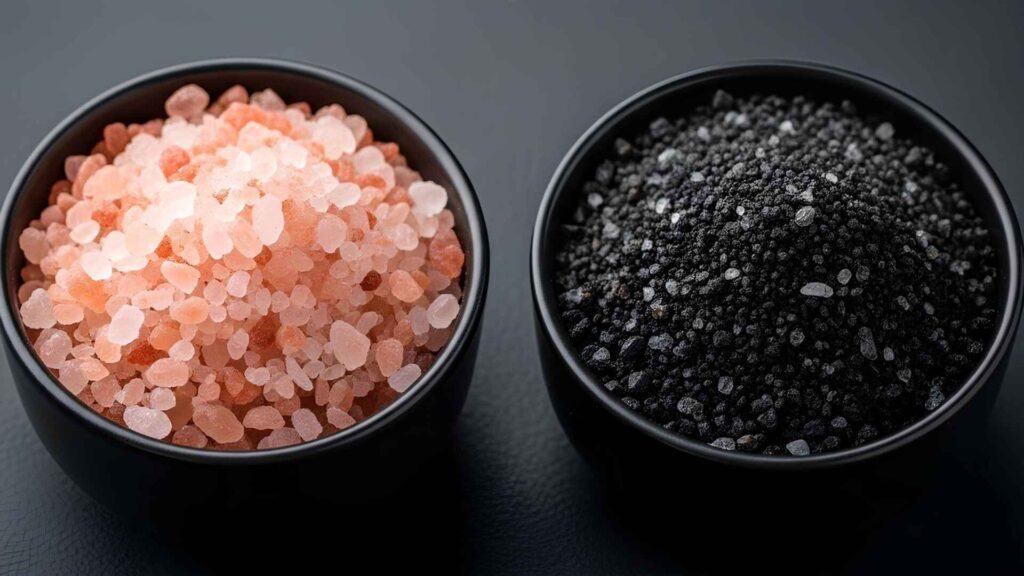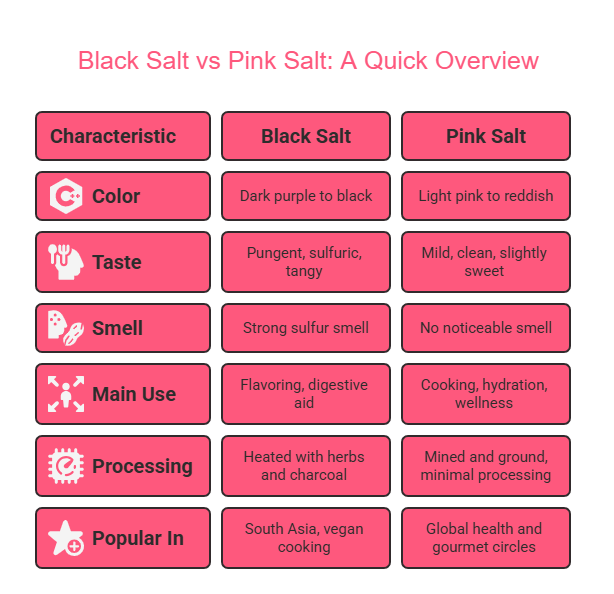Black Salt vs Pink Salt: Key Differences, Benefits & Best Uses Explained
- Zayan Rauf

Salt is a daily part of our lives. From kitchens to wellness routines, the type of salt we choose can impact both taste and health. Among the many varieties, black salt (Kala Namak) and pink Himalayan salt are two of the most popular natural options. Both are mined from the Himalayan region and are known for their unique color, taste, and mineral content.
But what exactly sets them apart? In this guide, we’ll compare black salt vs pink salt, looking at their origins, compositions, health benefits, and how they’re used. This will help you understand which one might be right for your diet or wellness routine.
Table of Contents

What Is Black Salt (Kala Namak)?
Black salt, also known as Kala Namak, is a volcanic rock salt commonly used in South Asian cuisine. Despite its name, its color can range from dark brown to pinkish-gray, and when ground, it usually appears dark purple or black.
What makes black salt unique is its sulfur-rich aroma and tangy, slightly egg-like flavor. This distinctive smell and taste come from natural sulfur compounds created during the heating and curing process.
It’s often used in:
- Chaats and chutneys
- Vegan and eggless recipes (as a flavor enhancer)
- Ayurvedic remedies for digestion and bloating
What Is Pink Himalayan Salt?
Himalayan pink salt is a mineral-rich salt mined from the Khewra Salt Mine in Pakistan. It’s known for its light pink to deep rose hue, which comes from trace minerals like iron, magnesium, and potassium.
Unlike table salt, it’s minimally processed and often comes in large crystals or fine powder.
Common uses include:
- Cooking and seasoning
- Salt lamps
- Bath soaks and detox scrubs
- Sole water (hydration)
Difference Between Black Salt and Pink Salt: A Quick Overview
Feature | Black Salt (Kala Namak) | Pink Himalayan Salt |
|---|---|---|
Color | Dark purple to black | Light pink to reddish |
Taste | Pungent, sulfuric, tangy | Mild, clean, slightly sweet |
Smell | Strong sulfur smell | No noticeable smell |
Main Use | Flavoring, digestive aid | Cooking, hydration, wellness |
Processing | Heated with herbs and charcoal | Mined and ground, minimal processing |
Popular In | South Asia, vegan cooking | Global health and gourmet circles |
Nutritional Composition: Minerals in Black Salt vs Pink Salt
Both salts are rich in natural minerals, but they differ in composition.
Trace Minerals in Pink Salt:
- Iron: gives it the pink color and supports oxygen transport in the body
- Magnesium: important for muscle and nerve function
- Calcium: supports bone health
- Potassium: helps maintain fluid balance
- Zinc, Chromium, and Manganese: found in small amounts
Pink salt may contain 84 trace minerals, though in very small quantities. It’s often chosen for those looking for a natural, unprocessed alternative to table salt.
Minerals in Black Salt:
- Iron and Magnesium: like pink salt
- Sulfur Compounds: responsible for their strong taste and digestive properties
- Sodium: slightly lower than table salt, making it a good alternative for some diets
If you’re wondering how to identify real Himalayan salt, pink salt often comes in natural crystal chunks or powder without any added chemicals. Black salt has a very specific sulfur smell and should not taste salty like regular table salt.
Read More: Does Black Salt Expire
Health Benefits Compared Black And Pink Salt
Health Benefits of Black Salt (Kala Namak):
- Supports digestion and reduces bloating
- It may help relieve heartburn and gas
- Believed to balance electrolytes in traditional medicine
- Often used in Ayurveda for detox and energy
Health Benefits of Pink Himalayan Salt:
- Hydration support when used in sole water
- Natural detox when added to baths
- May improve mineral balance in small quantities
- Gentle on the body due to the lack of additives
Culinary Uses of Black Salt vs Pink Salt
Kala Namak in Cooking:
Black salt’s sulfur taste makes it ideal for:
- Vegan recipes to mimic egg flavor
- Fruit salads, chaat, raitas
- Sprinkling on boiled eggs, cucumbers, or fried snacks
Pink Himalayan Salt in Cooking:
Pink salt is widely used as:
- A general-purpose cooking salt
- Finishing salt for roasted vegetables or grilled meats
- Salt block for grilling or serving cold dishes
- Sole water or detox drinks
Which Salt Is Better for You?
It depends on your needs.
Choose black salt if:
- You want digestive benefits
- You enjoy bold, tangy flavors
- You follow a vegan or Ayurvedic lifestyle
Choose pink Himalayan salt if:
- You want a mineral-rich cooking salt
- You’re replacing table salt for wellness
- You need salt for baths, hydration, or skin care
Read More: Understanding the Black Salt Market – Quality, Grades & Buying Tips
Final Thoughts
When comparing black salt vs pink salt, both bring something unique to the table. Whether it’s the sulfur-rich Kala Namak used for digestion or the mineral-rich Himalayan pink salt known for wellness and hydration, each has its benefits. Understanding the difference between black salt and pink salt helps you choose the right one based on your taste, health goals, and daily use.
For those looking for real Himalayan salt, always check the source, texture, and processing method to ensure quality. Natural color variations, rough texture, and minimal processing are good signs of authenticity.
Read Our Latest Salt Market Guides:
- Bulk Himalayan Salt Procurement: Navigating the Pakistani Market
- The Growing Demand for Himalayan Pink Salt in the Global Market
The global gourmet salt market; encompassing specialty salts like pink and black salt, was valued at around USD 1.35 billion in 2024 and is projected to rise to USD 2.75 billion by 2033, growing at about 7.9% CAGR. This growth is driven by culinary trends and increasing demand for premium, natural salts. (Source: Straits Research)
Share This Post
Article By

